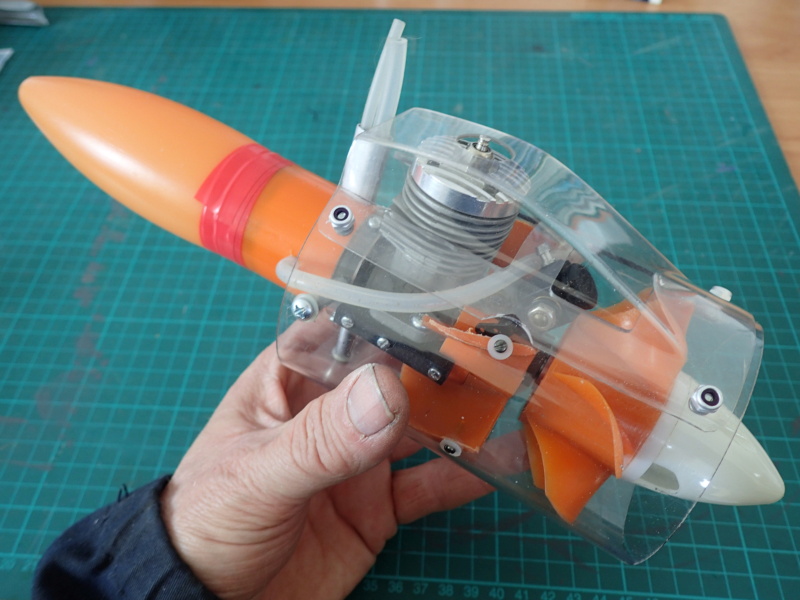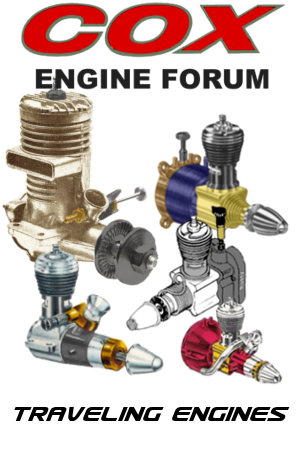Log in
Search
Latest topics
» Joe Wagners Siouxby GallopingGhostler Yesterday at 9:03 pm
» Roddie's flat-bottomed boat..
by rsv1cox Yesterday at 6:26 pm
» Happy Anzac Day!
by GallopingGhostler Yesterday at 4:16 pm
» Three -- sold out (making two more) Cox .010 Carburetors with wrench
by MauricioB Yesterday at 3:43 pm
» Jim Walkers FireBee - This is going to be fun
by rsv1cox Yesterday at 12:27 pm
» Project Cox .049 r/c & Citabrian Champion
by rdw777 Yesterday at 8:14 am
» Revivng Some Childhood Classics
by getback Yesterday at 7:31 am
» Fox .35 Modifications
by Ken Cook Yesterday at 3:16 am
» Introducing our Cox .049 TD Engines
by getback Fri Apr 26, 2024 6:20 am
» Cox powered jet-pump for model Sprint Boat
by roddie Thu Apr 25, 2024 10:25 pm
» Micro Draco Gets to Fly on a Beautiful Morning.
by rdw777 Thu Apr 25, 2024 8:15 pm
» Jim Walker Firebaby
by rdw777 Thu Apr 25, 2024 8:06 pm
Cox Engine of The Month
Engine Class Question
Page 1 of 1
 Engine Class Question
Engine Class Question
This might seem lick a dumb question. I have been looking at some old Cleveland Plans and have considered one for a winter project. I know that an .049 is 1/2A and .020 is 1/4A, then would .099 to .19 be considered A engines? If this is true, then would B engines run between .21 to .29 cubic inches? Then I take it that C engines are in the .30 range. What would a .60 engine be?

bsadonkill- Bronze Member

- Posts : 35
Join date : 2022-12-10
 RE: Engine Class Question
RE: Engine Class Question
Good question. If my memorie is correct:
.010 - .024 = 1/4 A
.039 - .o49 = 1/2 A
.06 - .15 = A
.19 - .35 = B
.010 - .024 = 1/4 A
.039 - .o49 = 1/2 A
.06 - .15 = A
.19 - .35 = B

Eddy- Silver Member

- Posts : 92
Join date : 2018-04-29
Age : 79
Location : Portage, Michigan
 Re: Engine Class Question
Re: Engine Class Question
.60 is C class.

Levent Suberk- Diamond Member

- Posts : 2204
Join date : 2017-12-24
Location : Türkiye
 Re: Engine Class Question
Re: Engine Class Question
AMA Freeflight classes.
101 Class 1/2A: .000-.0504 Cubic Inch
102 Class A: .0505-.2000 Cubic Inch
103 Class B: .201-.300 Cubic Inch
104 Class C: .301-.400 Cubic Inch
105 Class D: .401-.670 Cubic Inch
AMA Control line classes.
Class ½A: 0000—.0504 cubic inch
Class A: 0505—.1525 cubic inch
Class B: 1526—.3051 cubic inch
Class C: 3052—.4028 cubic inch
Class D: 4029—.6500 cubic inch
These can be found in the rules books.
101 Class 1/2A: .000-.0504 Cubic Inch
102 Class A: .0505-.2000 Cubic Inch
103 Class B: .201-.300 Cubic Inch
104 Class C: .301-.400 Cubic Inch
105 Class D: .401-.670 Cubic Inch
AMA Control line classes.
Class ½A: 0000—.0504 cubic inch
Class A: 0505—.1525 cubic inch
Class B: 1526—.3051 cubic inch
Class C: 3052—.4028 cubic inch
Class D: 4029—.6500 cubic inch
These can be found in the rules books.

gkamysz- Gold Member

- Posts : 377
Join date : 2018-02-22
Location : Chicagoland
 Re: Engine Class Question
Re: Engine Class Question
I think as far as selecting engines, wouldn't one take into account the wing area? Many of the free flight airframes are very light weight, so doesn't take much to power them. RC tended to be heavier framed, but they carried a payload, which was the RC gear and batteries. A slight more robustness helped them to sustain rougher landings, IMO.
It is interesting that for free flight, some of the aircraft could be considered for half-A if they used say, a Medallion or Tee Dee .049, but then place it also in an "A" contest class, if they used the same equipped with the .051 cylinder and piston. The Berkeley 51 in. wingspan PAA Payee was one such airplane. The R/C gear and batteries could serve as the "payload".
https://outerzone.co.uk/plan_details.asp?ID=1841 51 in. wingspan Payee by Woody Blanchard, Berkeley 1955
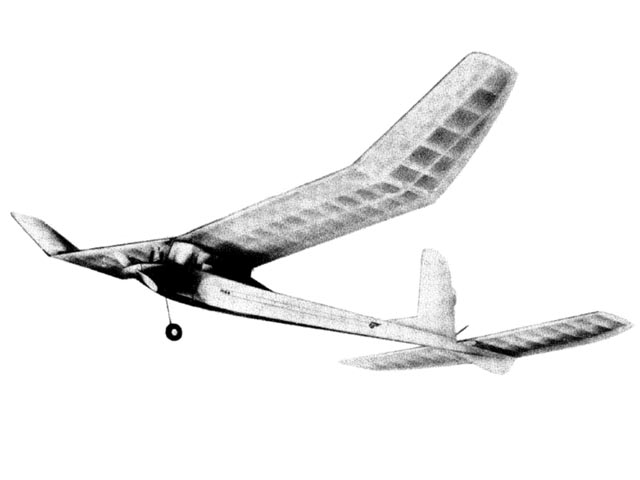
Outerzone photo
I don't know if I will ever be able to do it, but one inspiration would be to build such for R/C. It would be a real floater, probably not much different than a powered glider, except that they were designed under power to get up to altitude quickly, then enter a very flat glide with thermaling capability.
It is interesting that for free flight, some of the aircraft could be considered for half-A if they used say, a Medallion or Tee Dee .049, but then place it also in an "A" contest class, if they used the same equipped with the .051 cylinder and piston. The Berkeley 51 in. wingspan PAA Payee was one such airplane. The R/C gear and batteries could serve as the "payload".
https://outerzone.co.uk/plan_details.asp?ID=1841 51 in. wingspan Payee by Woody Blanchard, Berkeley 1955

Outerzone photo
I don't know if I will ever be able to do it, but one inspiration would be to build such for R/C. It would be a real floater, probably not much different than a powered glider, except that they were designed under power to get up to altitude quickly, then enter a very flat glide with thermaling capability.

GallopingGhostler- Top Poster


Posts : 5302
Join date : 2013-07-13
Age : 70
Location : Clovis NM or NFL KC Chiefs
 Re: Engine Class Question
Re: Engine Class Question
Thanks for the input! Most plans I have seen that are considered 1/2A are around or just under 300 square inches. The problem is some plans I have come across are refed to by class. Cleveland's Viking is considered suitable for Class A or Class B. This was probably back in the older spark ignition days. It looks from the AMA classes that you probable could get away with a .051 glow engine.

bsadonkill- Bronze Member

- Posts : 35
Join date : 2022-12-10
 SAM rules for Model Airplanes
SAM rules for Model Airplanes
There are also the rules for SAM (Society of Antique Models)
Their rules include the Diesel engines, Spark Ignition, and Glow.
Loop Scavenged vs. Schnuerle Ported vs. Spark Ignition vs. Diesel engines on timed runs and fuel.
And of course, the engines class sizes.
Their rules specify wing area for certain high-powered glow engines.
Here is a link to their website for their rules on model engines.
http://www.antiquemodeler.org/sam_new/rulebooks/Rulebook-Booklet-January%202020%20FINAL.pdf
I've been a SAM member since 1994
SAM has the 1/2A Texaco R/C event which you use a Cox .049 (unmodified) engine and flew your 1/2A plane for 15 minutes (engine run and gliding after the engine quit. -- for your total flight time)
You had three flights to get at least 2 maxes. (of 15 minutes)
The original event used the 8cc tank but later on the rules were changed to the 5cc tank (smaller) because it was a very popular event and at times there was always a fly-off at the end of the day with so many people with the 2 max flight times.
With the smaller tank, there were much less people in the fly-off at the end of the day to sometimes no fly-off because no-one maxed out.
Then everyone started to fly smaller planes (around 225 sq in) and it was back to the same problem with max flights and now harder, smaller planes to see in the sky. So, I stopped flying the event along with others and that has become an event that is not that popular anymore.
Anyway, When I was flying the 1/2A (.049) Texaco R/C event with the 8cc tank, I was flying a Playboy Sr. at 50" wing span (about 300sq. in. wing area)
After flying the 1/2A event, I would remove my Cox Texaco .049 engine and install my modified Cox Texaco engine with the .051 piston/cylinder assembly and fly my 50" Playboy Sr. in the "A" Texaco event.
The "A" class was .051 to .20 size engines and a fuel allotment of 14cc.
Here is a photo of my 1st try for an engine for the "A" Texaco event.
A Cox Texaco engine with a .051 piston/sleeve and a special made fuel tank.

On my 2nd Cox engine to get the 14cc of fuel I used a Kavan tank extender to increase the 8cc original tank to the 14cc size fuel allotment and the rules have it where you have to have a fuel cutoff, so I installed a throttle ring to choke off the exhaust ports to stop the engine.
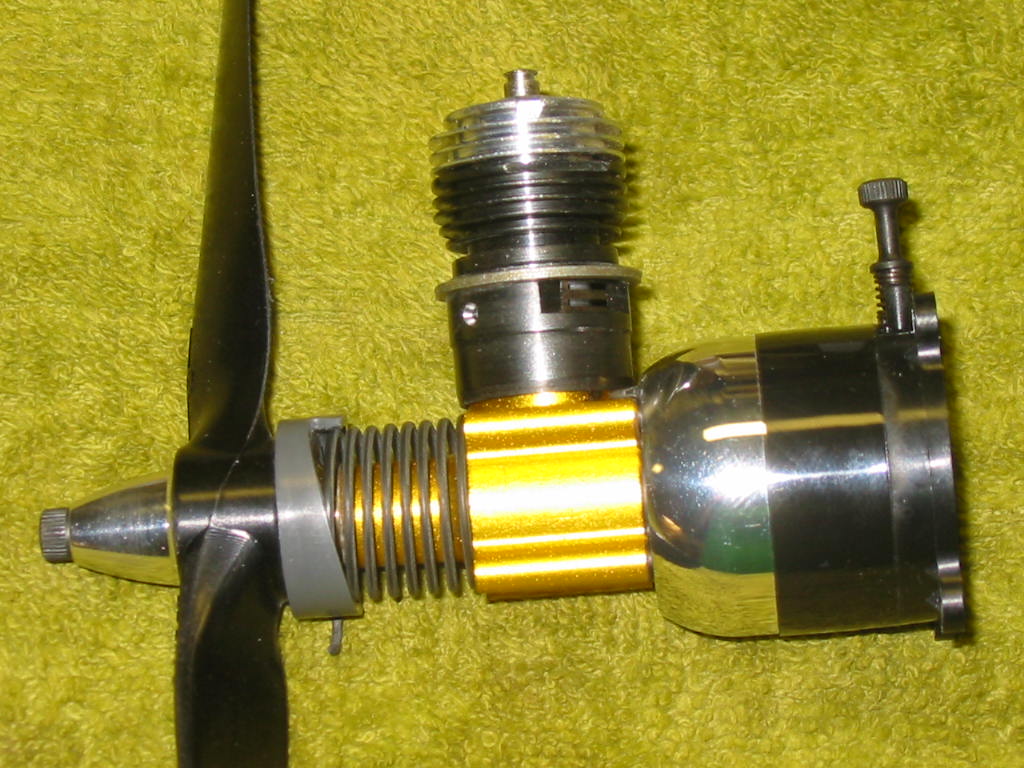
I did win the "A" class Texaco a couple of times until the diesel engines took over and started winning.
Later rules reduced the fuel allotment for the diesels to 8cc, and for my plane they changed the rules to where the plane had to have a minimum of a 10oz. wing loading. (my Playboy Sr. was almost 8oz. wing loading.)
Mike Mac
Their rules include the Diesel engines, Spark Ignition, and Glow.
Loop Scavenged vs. Schnuerle Ported vs. Spark Ignition vs. Diesel engines on timed runs and fuel.
And of course, the engines class sizes.
Their rules specify wing area for certain high-powered glow engines.
Here is a link to their website for their rules on model engines.
http://www.antiquemodeler.org/sam_new/rulebooks/Rulebook-Booklet-January%202020%20FINAL.pdf
I've been a SAM member since 1994
SAM has the 1/2A Texaco R/C event which you use a Cox .049 (unmodified) engine and flew your 1/2A plane for 15 minutes (engine run and gliding after the engine quit. -- for your total flight time)
You had three flights to get at least 2 maxes. (of 15 minutes)
The original event used the 8cc tank but later on the rules were changed to the 5cc tank (smaller) because it was a very popular event and at times there was always a fly-off at the end of the day with so many people with the 2 max flight times.
With the smaller tank, there were much less people in the fly-off at the end of the day to sometimes no fly-off because no-one maxed out.
Then everyone started to fly smaller planes (around 225 sq in) and it was back to the same problem with max flights and now harder, smaller planes to see in the sky. So, I stopped flying the event along with others and that has become an event that is not that popular anymore.
Anyway, When I was flying the 1/2A (.049) Texaco R/C event with the 8cc tank, I was flying a Playboy Sr. at 50" wing span (about 300sq. in. wing area)
After flying the 1/2A event, I would remove my Cox Texaco .049 engine and install my modified Cox Texaco engine with the .051 piston/cylinder assembly and fly my 50" Playboy Sr. in the "A" Texaco event.
The "A" class was .051 to .20 size engines and a fuel allotment of 14cc.
Here is a photo of my 1st try for an engine for the "A" Texaco event.
A Cox Texaco engine with a .051 piston/sleeve and a special made fuel tank.

On my 2nd Cox engine to get the 14cc of fuel I used a Kavan tank extender to increase the 8cc original tank to the 14cc size fuel allotment and the rules have it where you have to have a fuel cutoff, so I installed a throttle ring to choke off the exhaust ports to stop the engine.

I did win the "A" class Texaco a couple of times until the diesel engines took over and started winning.
Later rules reduced the fuel allotment for the diesels to 8cc, and for my plane they changed the rules to where the plane had to have a minimum of a 10oz. wing loading. (my Playboy Sr. was almost 8oz. wing loading.)
Mike Mac

sosam117- Diamond Member

- Posts : 1285
Join date : 2016-03-23
Location : Suburb of Chicago, Illinois
 Similar topics
Similar topics» Tach Race 2015 Final Wrap-Up
» Class I Cox Vintage Speed secrets...
» A Mid-70’s engine question.
» OS Max .010 10 FSR RC Engine question
» Yet another engine question....
» Class I Cox Vintage Speed secrets...
» A Mid-70’s engine question.
» OS Max .010 10 FSR RC Engine question
» Yet another engine question....
Page 1 of 1
Permissions in this forum:
You cannot reply to topics in this forum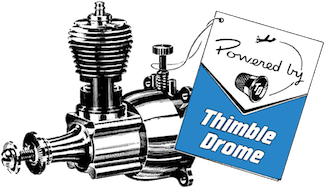

 Rules
Rules
